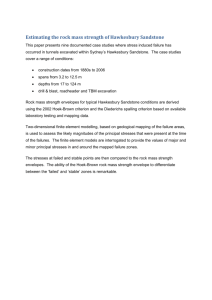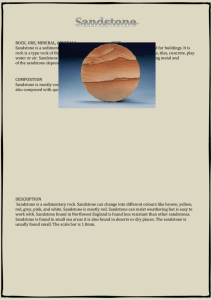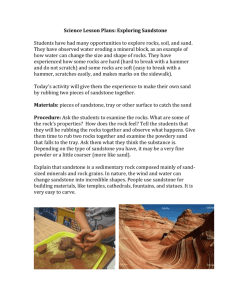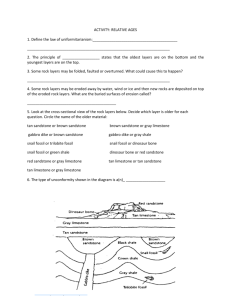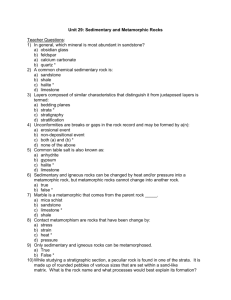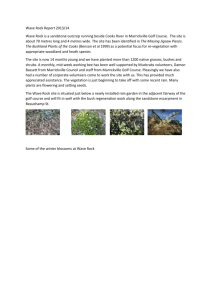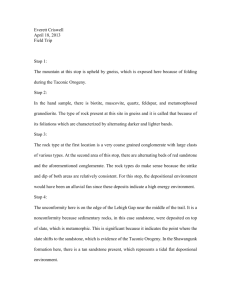Materials for Mr
advertisement
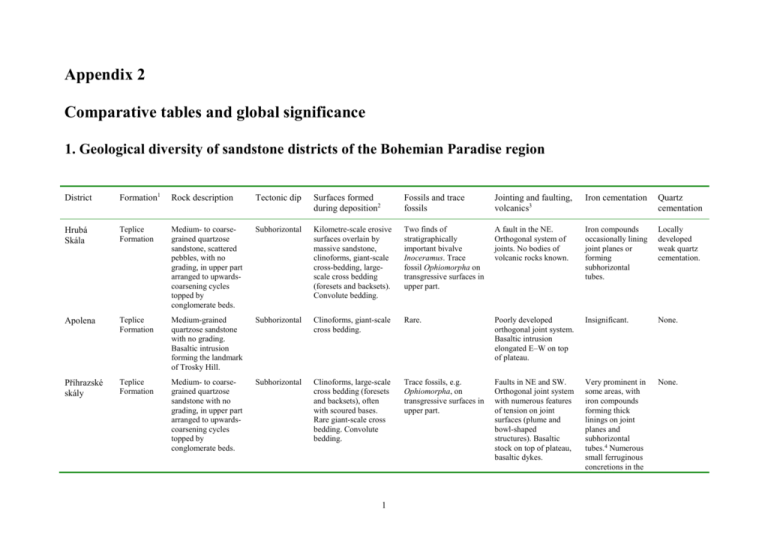
Appendix 2 Comparative tables and global significance 1. Geological diversity of sandstone districts of the Bohemian Paradise region District Formation1 Rock description Tectonic dip Surfaces formed during deposition2 Fossils and trace fossils Jointing and faulting, volcanics3 Iron cementation Quartz cementation Hrubá Skála Teplice Formation Medium- to coarsegrained quartzose sandstone, scattered pebbles, with no grading, in upper part arranged to upwardscoarsening cycles topped by conglomerate beds. Subhorizontal Kilometre-scale erosive surfaces overlain by massive sandstone, clinoforms, giant-scale cross-bedding, largescale cross bedding (foresets and backsets). Convolute bedding. Two finds of stratigraphically important bivalve Inoceramus. Trace fossil Ophiomorpha on transgressive surfaces in upper part. A fault in the NE. Orthogonal system of joints. No bodies of volcanic rocks known. Iron compounds occasionally lining joint planes or forming subhorizontal tubes. Locally developed weak quartz cementation. Apolena Teplice Formation Medium-grained quartzose sandstone with no grading. Basaltic intrusion forming the landmark of Trosky Hill. Subhorizontal Clinoforms, giant-scale cross bedding. Rare. Poorly developed orthogonal joint system. Basaltic intrusion elongated E–W on top of plateau. Insignificant. None. Příhrazské skály Teplice Formation Medium- to coarsegrained quartzose sandstone with no grading, in upper part arranged to upwardscoarsening cycles topped by conglomerate beds. Subhorizontal Clinoforms, large-scale cross bedding (foresets and backsets), often with scoured bases. Rare giant-scale cross bedding. Convolute bedding. Trace fossils, e.g. Ophiomorpha, on transgressive surfaces in upper part. Faults in NE and SW. Orthogonal joint system with numerous features of tension on joint surfaces (plume and bowl-shaped structures). Basaltic stock on top of plateau, basaltic dykes. Very prominent in some areas, with iron compounds forming thick linings on joint planes and subhorizontal tubes.4 Numerous small ferruginous concretions in the None. 1 SE. Plakánek Teplice Formation Medium- to coarsegrained quartzose sandstone with no grading, in upper part arranged to upwardscoarsening cycles topped by conglomerate beds. Subhorizontal Steep clinoforms. Trace fossils, e.g. Ophiomorpha, on transgressive surfaces in upper part. A fault in the south. Orthogonal system of joints. No bodies of volcanic rocks known. Present precipitation of iron in the flood plain. None. Kozlov (Chlum) Teplice Formation Medium- to coarsegrained quartzose sandstone with no grading. Subhorizontal Clinoforms, large-scale cross bedding. Convolute bedding. Unique assemblage of trace fossils on bedding planes including crawling traces (Cruziana) and fishresting traces (Piscichnus).5 Well developed orthogonal joint system. No bodies of volcanic rocks known. Insignificant. None. Prachovské skály Teplice Formation Medium-grained quartzose sandstone with no grading. 0–10° W Clinoforms, giant-scale cross bedding. Rare bivalve shells. Remains of ice-age mammals in caves. Trace fossils common. Orthogonal joint system but E–W-striking joints clearly dominant, locally penetrated by basaltic magma (dykes, stocks). Iron compounds lining joint planes. None. Klokočské skály Teplice Formation Medium- grained quartzose sandstone, no grading. 5–13° SSW Clinoforms, giant-scale cross bedding. Bivalve bed also containing stratigraphically important bivalve Inoceramus.7 Trace fossils common, including rare Megaplanolites and Gyrolithes. Ferruginized wood fragments. Fault bounding the district in the NE. Orthogonal system of joints of mostly compressional character. Sets of prominent deformation bands. Rare polished surfaces of minor fault planes. No bodies of volcanic rocks known. Iron compounds lining joint planes or forming subhorizontal tubes. Quartz cementation as a product of tectonic movement in deformation bands. Drábovna Teplice Formation Fine- to mediumgrained quartzose sandstone with no grading, in upper part arranged to upwardscoarsening cycles. 3–5° SW Clinoforms, large-scale cross bedding. Rare. Poorly developed orthogonal joint system, dominated by structures transverse to the Lusatian Fault running 1 km to the NE. Deformation bands Iron compounds occasionally lining joint planes. Quartz cementation as a product of tectonic movement in deformation bands. 2 present. Teplice Formation Fine- to mediumgrained quartzose sandstone with no grading. 5–10° S to SE Wavy erosional surfaces and large-scale cross bedding. Giantscale cross bedding near top. Occasional clinoforms. Ferruginized wood fragments. Jizera Formation Fine-grained silty calcareous sandstone. 5–10° S to SE Parallel stratification. Common mollusc shells in life position, foraminifers. Numerous trace fossils. Borek Teplice Formation Medium- to coarsegrained quartzose sandstone arranged into upwardscoarsening cycles. 5–10° SW Clinoforms, large-scale cross bedding. Suché skály PerucKorycany Formation Medium- to coarsegrained quartzose sandstone with conglomerate beds. Subvertical. Kozákov PerucKorycany Formation Medium- to coarsegrained quartzose sandstone underlain by coaly claystone. 24–45° WSW Sokol Orthogonal joint system linked with the Lusatian Fault 1 km to the NE. Deformation bands present. Several basaltic intrusive bodies. Botryoidal clusters of ferruginous concretions. Iron compounds also forming subhorizontal tubes and locally prominent tube bundles.4 Trace fossils common. Orthogonal system of joints, with prevailing strike NW–SE. One such joint hosts a continuous basaltic dyke subparallel to cuesta edge. Iron compounds concentrate to joint planes and subhorizontal tubes parallel to the basaltic dyke.4 Parallel stratification and large-scale cross bedding. Rare bivalve shells. Trace fossils on bedding planes. Sandstone belt aligned parallel to the adjacent Lusatian Fault and dissected by several systems of joints and faults.8 Common deformation bands, polished surfaces and slickensides. No bodies of volcanic rocks known. Linings of iron compounds on joints transverse to the Lusatian Fault. Quartz cementation culminating in zones of maximum shear (deformation bands). Parallel stratification and large-scale cross bedding. Rare bivalve and gastropod shells in sandstone. Bivalve shells and terrestrial plants in coaly claystone. Orthogonal joint system linked with the adjacent Lusatian Fault and a transverse fault. Deformation bands and polished surfaces of fault planes present. Huge basaltic stock and Iron compounds lining joint planes.4 Quartz cementation as a product of tectonic movement in deformation bands. 3 Quartz cementation as a product of tectonic movement in deformation bands. lava flow beyond the E and N limits. 1 All sandstones extensively exposed in the Bohemian Paradise are Upper Cretaceous in age. The Teplice Formation is Upper Turonian to Lower Coniacian in age, the Jizera Formation is Middle to Upper Turonian in age, and the Peruc-Korycany Formation is Middle to Upper Cenomanian in age, see Čech S., Klein V., Kříž J. and Valečka J. (1980): Revision of the Upper Cretaceous stratigraphy of the Bohemian Cretaceous Basin. Věst. Ústř. Úst. geol., 55: 277-296. The term “clinoforms” refers to gently dipping surfaces interpreted as foresets of a subaquatic delta body, often traceable for tens of metres in vertical succession. Clinoforms are occasionally associated with horizontal bedding planes interpreted as delta topsets. Sets of giant-scale cross bedding reach thicknesses of 1–10 m, sets of large-scale cross bedding reach thicknesses of 0.1–0.4 m. The latter are often incorporated in the former and show not only foresets but also backsets. This concept follows the paper of Uličný D. (2001): Depositional systems and sequence 2 stratigraphy of coarse-grained deltas in a shallow-marine, strike-slip setting: the Bohemian Cretaceous Basin, Czech Republic. Sedimentology, 48, 3: 599-628. 3 Orthogonal joint system is commonly met in all rock cities, giving rise to pillars with rectangular bases, as reflected by the German name Quadersandstein. In the proximity of major faults, “joints” of this system function as splay faults. Tensional and compressional joints are distinguished. Deformation bands are zones of maximum shearing (i.e., sliding of blocks parallel to their plane of contact) 1–20 cm wide, with grain crushing and cataclasis, and frequent quartz dissolution/reprecipitation phenomena. Mertlík J., Adamovič J. and Nešporová M. (2002). Český ráj. In: Adamovič J. and Cílek V. (Editors), Železivce české křídové pánve. Zlatý Kůň, pp. 105-127. Praha. (in Czech, English abstract) 4 5 Mikuláš R. and Mertlík J. (2002). Nové poznatky o ichnostavbě kvádrových pískovců české křídové pánve. Zpr. geol. Výzk. v Roce 2001: 49-52. Soukup J. (1936). Inoceramová lavice v kvádrovém pískovci svrchního turonu pod Vyskří u Turnova. Čas. Nár. Mus., 109 (1935), 92-96; Andert H. (1934). Die Kreideablagerungen zwischen Elbe und Jeschken. Teil III. Die Fauna der obersten Kreide in Sachsen, Böhmen und Schlesien. Abh. Preuss. Geol. Landesanstalt, Neue Folge, 159, p. 106, 441. 6 p. 144 in Krejčí J. (1870). Studie v oboru křídového útvaru v Čechách. I. Všeobecné a horopisné poměry, jakož i rozčlenění křídového útvaru v Čechách. Arch. přírodověd. Prosk. Čech, I, II: 35-161. 7 Coubal M. (1990). Compression along faults: example from the Bohemian Cretaceous Basin. Miner. Slovaca, 22: 139-144; Budil P., Štěpánek P., Adamovič J., Coubal M., Chlupáč I., Opletal M. and Valečka J. (1999). Examples of important geological localities in the Sudetes (Czech Republic). Polish Geol. Inst. Spec. Pap., 2, p. 31. 8 4 2. Geomorphic diversity of sandstone districts of the Bohemian Paradise region District Maturity1 Large forms of sandstone relief Sinks Caves and rock shelters Rock perforations Pitted surfaces, niches and tafone Furrows2 Salt weathering and case hardening Hrubá Skála Mature Dissected sandstone plateau. Tens of isolated pillars 40–80 m in height, especially on NE plateau rim. Narrow passages developed locally. Numerous well developed sinkholes. Tens of caves on bedding planes or joints. Prominent rock shelters. A dozen arches, the largest 5.5 m in height and 7 m in span. Many false arches and rock windows. Honeycomb pits common: arcuate, rhomboidal or spherical in shape. Tafone common, their inner surfaces with well-developed honeycombs. Occasional karren on tops of pillars, tree grooves. Crusts locally present, in stage of destruction. Apolena Incipient Dissected edge of a sandstone plateau. Oblique ledges at pillar bases indicating ancient soil surfaces. None. Tens of caves developed on bedding planes. Cave 200 m long developed on a dilated joint. Tens of arches and rock windows. Honeycomb pits of rhombic shape dominant. Nesting pits of solitary bees. None. Crusts mostly destructed but morphologically prominent. Příhrazské skály Incipient to mature Dissected edges of a sandstone plateau, with pillars and needles 50 m high in the west. Network of canyon-like valleys in the centre, with pillars 15–20 m high. Two table mountains in the SE. Oblique ledges at pillar bases indicating ancient soil surfaces. Numerous sinkholes; one of them open to form an abyss 22 m deep. Solution basins present. Tens of caves and rock shelters in the central and SE parts. A dozen arches, the largest of which is 10 m in height and 7.5 m in span. Tens of false arches, tens of rock windows. Honeycomb pits common, highly variable (arcuate, spherical, cellular). Specific microrelief linked with ferruginous linings and concretions (papillate surface). Nesting pits of solitary bees. Karren common on tops of pillars and table mountains. Crusts present, in various stages of destruction. Plakánek Incipient Sandstone cliffs lining a valley with a stream and side valleys. Flood plain. Calcareous tufa cascades. Potholes. Caves formed by gravity-induced joint dilation or following bedding planes. Rock windows occasionally present. Honeycomb pits scarce, widely spaced. None. Crusts present. Kozlov (Chlum) Senile Sandstone cliffs and pillars lining an E–W-trending ridge. Well Prominent sinkholes, Caves formed by gravity-induced Several false arches present. Prominent reorientated None. Crusts present. 5 developed oblique ledges at cliff bases indicating ancient soil surfaces. Rows of leaning pillars are a typical feature. elongated in plan view. joint dilation or among large fallen blocks in talus; the largest cave is 20 m long. honeycomb pits on fallen blocks, often horizontally elongated. Prachovské skály Mature Dissected sandstone plateau. Tens of pillars and needles 50–70 m in height, separated by narrow passages. Numerous sinkholes. A dozen caves developed on joints or among fallen blocks. False arches present. Honeycomb pits common, spherical in shape or vertically elongated. Karren common on tops of pillars. Crusts present. Klokočské skály Mature Dissected edge of a sandstone cuesta, with pillars 40 m high on the NE rim. Network of canyonlike valleys in the centre, with pillars 10–20 m high. Mushroom rocks present. About 40 well developed sinkholes ca. 10 m in diameter. Potholes max. 1 m deep and solution basins present. About 300 caves, mostly following bedding planes and subhorizontal fault planes, formed by tafone enlargement. The largest cave is 75 m long. Hundreds of rock shelters. Tens of rock windows, the largest windows 3 m in diameter. Tens of arches up to 12 m high and several false arches near cuesta rim. Double arch 1.9 m in height and 6.8 m in span. Tafone and niches common. Their merging produces tunnels up to 9.3 m long. Honeycomb pits common, spherical in shape or vertically elongated. Occasional karren on tops of pillars. Series of vertical furrows on steep walls produced by dripping water or controlled by courses of deformation bands. Frequent tree grooves. Crusts locally present, in stage of destruction. Drábovna Mature Dissected sandstone plateau. Solution basins common. Tens of rock shelters. Frequent perforations near tops of towers. Arch. Honeycombs scarce. Sokol Mature to senile Dissected sandstone plateau with pillars up to 20 m high separated by narrow passages. Leaning or fallen pillars common. Sinkholes and solution basins occasionally present. Caves mostly formed among fallen sandstone blocks. Tens of rock shelters. Small dissolution caves formed in calcareous sandstone. Rock windows present. Tens of false arches. Honeycomb pits locally well developed, aligned along deformation bands. Smaller tafone and niches scarce. Borek Mature Dissected edge of a sandstone cuesta and a network of canyonlike valleys in the centre. Honeycombs present. Tafone and niches up to 1 m in diameter. 6 Crusts present. Frequent tree grooves. Crusts present. Crusts well developed, also present inside tafone. Suché skály Senile Prominent sandstone ridge 80 m wide and 1000 m long, pillars and needles max. 80 m high. Faultcontrolled subhorizontal ramps developed. None. Insignificant. False arches present. Honeycombs present but scarce. Karren controlled by course of bedding planes. None. Kozákov Incipient Tilted sandstone block rimmed by sandstone cliffs. None. Tens of caves and large rock shelters formed along bedding planes. Rock windows and false arches present. Honeycombs locally well developed, pits horizontally elongated or filled with salt crusts. Karren present. Crusts mostly destructed but morphologically prominent on lower parts of cliffs. 1 This feature relates to the stage in the evolution of the sandstone landscape. This does not depend on the real time for which erosion takes place but on the position of the sandstone area relative to the local base level (stream), its tectonic position (subsidence vs. uplift), footwall stability and rock resistance. “Incipient stage” refers to plateau edges dissected by a system of dilated joints, “mature stage” to fully developed rock cities with high pillars surrounding multiple relics of the original plateau, now deeply incised. The term “senile stage” describes sandstone areas dominated by boulders and fallen pillars, formed by complete destruction of the original plateau. Each of these stages is characterized by a different set of forms of sandstone relief. Suché skály Cliffs represent erosive relief on an uplifted block where a belt of resistant sandstone forms prominent relief. 2 Furrows include different types of linear depressions in sandstone relief, usually tens of centimetres in size. They include drainage runnels (e.g., rillenkarren, wandkarren) and tree grooves produced on vertical rock surfaces by movement of living trees. 3. Geology and geomorphology of related sandstone regions of the world Sandstone region Climatic zone Age, genesis Rock description Characteristic Surfaces formed during deposition Cementation Tectonic deformatio n Caves and rock shelters Medium forms of relief Small forms of relief Salt weathering and case hardening Bohemian Paradise, Czech Republic Temperate . Cretaceous, shallow marine. Sandstone Faulted and partly tilted plateau, often dissected to form rock cities. Delta foresets, erosional surfaces, different types of cross bedding. Ferruginous cement locally prominent. Quartz cement. Faults, slickensides , deformation bands, joints. Intrusive bodies. Different types of caves, rock shelters. Arches and rock windows, sinkholes, potholes, solution basins. Rare tufa Karren and grooves, ledges, different types of well developed pitted Crusts present, locally prominent. 7 accumulat ions. surfaces (honeycomb s, tafone). Bohemian/Saxonia n Switzerland NP, Czech Republic/ Germany1,2 Temperate . Cretaceous, shallow marine. Sandstone. Faulted plateau, often dissected to form rock cities. Different types of cross bedding, delta foresets. Ferruginous cement locally prominent. Faults, slickensides , deformation bands, joints. Intrusive bodies. Different types of caves, rock shelters. Arches and rock windows, mushroom rocks, potholes, solution basins. Karren and grooves, ledges, different types of pitted surfaces. Crusts present. Wulingyuan Scenic and Historic Interest Area, China3 Temperate . Cretaceous, shallow marine. Quartzite, shale. Limestone. Plateau margin dissected by the Suoxi Brook and its tributaries. Sets of isolated pillars and pinnacles, canyons, waterfalls. Parallel stratification. Quartz cement. Vertical joints. Large caves (but in limestones ). Arches and rock windows, natural bridges. Insignificant . None. Greater Blue Mountains, Australia4-6 Temperate . Triassic to Permian, fluvial and marine Sandstone, shale with coal seams. Limestone. Plateau dissected by canyons to form steep cliffs, ridges, pillars, pinnacles and pagodas. Parallel stratification, cross bedding. Different types of cement, especially ferruginous cement. Faults, vertical joints. Intrusive and volcanic bodies. Caves and rock shelters. Large caves in limestones . Mushroo m rocks. Irregular pits, ledges. Crusts present, locally prominent. High Weald, England7-8 Temperate . Cretaceous, shallow marine Sandstone. Cliffs along valley sides. Parallel stratification, cross bedding. None. Joints. Rock shelters. Solution basins. Karren, pitted surfaces (honeycomb s), polygonal cracking. Crusts well developed, important for outcrop preservation . Meteora Group of Monasteries, Greece9 Subtropica l, oceanic. Tertiary, deltaic and alluvial fan. Conglomerate , sandstone. Eroded delta body forming isolated rock pillars. Delta foresets, cross bedding. Calcitic cement. Vertical joints. Large cavities and rock shelters. Irregular pits, ledges. Insignificant . Tassili n´Ajjer, Subtropica l, arid. Ordovician and Sandstone. Crystalline Tilted plateau dissected by Parallel stratification. Ferruginous cement. Faults and joints. Caves and rock Ledges, eolian pits, Crusts locally 8 Arches and rock Algeria10-11 Devonian, shallow marine. Proterozoic. rocks. gorges to form rock cities and pillars. Volcanic bodies. shelters. windows. faceted surfaces. prominent. Desert varnish. Zion NP, USA12-13 Subtropica l, arid. Jurassic, eolian, fluvial and deltaic. Sandstone, siltstone. Plateau dissected by the Virgin River and its tributaries. Table mountains, steep walls, canyons. Welldeveloped different types of cross bedding. Different types of cement, especially ferruginous cement. Vertical joints. Intrusive bodies. Rock shelters common, often represente d by imperfectl y developed arches. Mushroo m rocks (hoodoos), arches and rock windows, potholes. Small tufa accumulat ions. Tafone, relicts of pitted surfaces. Desert varnish, opal and salt coatings, coatings of blue-green algae. Arches NP, USA13- Subtropica l, arid. Jurassic, eolian, fluvial. Sandstone 15 Edge of faulted and folded plateau eroded by tributaries of the Colorado River. Salt domes in footwall. Rock cities and isolated pillars. Different types of cross bedding. Different types of cement, especially ferruginous and quartz cement. Faults with slickensides , deformation bands, prominent folds, cleavage planes, joints. Rock shelters common, often represente d by imperfectl y developed arches. Fins, perfectly developed arches and rock windows, potholes. Tafone, relicts of pitted surfaces. Solution furrows. Desert varnish, opal and salt coatings. Canyonlands NP, USA16 Subtropica l, arid. Jurassic to Pennsylvania n, eolian, fluvial and shallow marine. Sandstone, siltstone. Plateau dissected by the Colorado and Green Rivers. Salt domes in footwall. Meteorite impact. Table mountains, deep canyons, rock cities and isolated pillars. Different types of cross bedding. No prominent cementation. Faults, prominent folds, cleavage planes, joints. Rock shelters common. Fins, rock needles, mushroom rocks, arches and rock windows. Tafone, relicts of pitted surfaces. Desert varnish, opal and salt coatings. Mesa Verde NP, USA17 Subtropica l, arid. Cretaceous, shallow marine and eolian. Sandstone, shale, coal seams. Plateau dissected by canyons with seasonal streams. Table mountains. Cross bedding, parallel stratification. No prominent cementation. Joints. Huge rock shelters. Tafone, relicts of pitted surfaces. Desert varnish. 9 Colorado NM, USA17 Subtropica l, arid. Triassic and Jurassic, eolian and shallow marine Sandstone. Plateau dissected by canyons with seasonal streams. Cliffs, domes, isolated pillars. Cross bedding, ripples, parallel stratification. No prominent cementation. Joints. Canaima NP, Venezuela18-21 Tropical, humid. Proterozoic, shallow marine and lacustrine. Sandstone, quartzite, Plateau dissected by canyons with Río Venamo and Río Caroní rivers. Table mountains, waterfalls. Different types of cross bedding, ripples, parallel stratification. Quartz cement, rare ferruginous concretions. Joints, intrusive bodies. Caves hundreds of metres long formed by quartz dissolutio n. Rock shelters. Sinkholes, arches and false arches, mushroom rocks, solution basins. Grooves following joints, rarely developed pitted surfaces. Silcrete. Jurassic, shallow marine. Sandstone. Rock walls, block accumulations and rare pillars on seashore and in glacial troughs. Cross bedding, ripples, parallel stratification. Quartz cement. Joints. Caves among fallen blocks. False arches. Ledges, rare pitted surfaces None. Jameson Land, Greenland22 1 Rast Desert varnish. H. (1959). Geologischer Führer durch das Elbsandsteingebirge. Bergakademie Freiberg, 224 p. 2 Vařilová 3 Yan Arctic. quartz veins. Arches and rock windows, mushroom rocks. Z. (2002). České Švýcarsko. In: Adamovič J. and Cílek V. (Editors), Železivce české křídové pánve. Zlatý Kůň, pp. 73-95. Praha. (in Czech, English abstract) F. (2003). Conservation for the landscape ecological diversity in Wulingyuan scenic area of China. Jour. Envir. Sci.-China, 15: 284-288. 4 Pickett 5 Wray J.W. and Bishop P. (1992). Aspects of landscape evolution in the Lapstone Monocline Area, New South Wales. Austr. J. Earth Sci., 39: 21-28. R.A.L. (1995). Solutional landforms in quartz sandstones of the Sydney Basin. Unpubl. PhD. Thesis. Univ. of Wollongong, 381 p. 6 van der Beek P., Pulford A. and Braun J. (2001). Cenozoic landscape development in the Blue Mountains (SE Australia): Lithological and tectonic controls on rifted margin morphology. J. Geol., 109: 35-56. 7 Robinson D.A. and Williams R.B.G. (1976). Aspects of the geomorphology of the sandstone cliffs of the central Weald. Proc. Geologists' Assoc., 87: 93-100. 8 Robinson D.A. and Williams R.B.G. (1981). Sandstone cliffs on the High Weald landscape. Geogr. Mag., 53: 587-592. 9 Ori G.G. and Roveri M. (1987). Geometries of Gilbert-type deltas and large channels in the Meteora Conglomerate, Meso-Hellenic Basin (Oligomiocene), central Greece. Sedimentology, 34: 845-859. 10 Busche D. and Erbe W. (1987). Silicate karst landforms of the southern Sahara, northeastern Niger and southern Libya. Z. Geomorphol., Suppl. 64: 55-72. 10 11 Hertig S.P., Tye R.S., Coffield D.Q., et al. (1991). Depositional systems and stratigraphy of Paleozoic and Lower Mesozoic rocks in outcrop, Tassili region, southwest Algeria. Assoc. Amer. Petrol. Geol. Bull., 75: 1412. 12 Robinson 13 Chronic E.R. (1970): Mechanical disintegration of the Navajo sandstone in Zion Canyon, Utah. Geol. Soc. Am. Bull., 81: 2799-2806. H. (1990). Roadside geology of Utah. Mountain Press Publishing Co., Missoula. 14 Doelling H. (1985). Geology of Arches National Park. Utah Geological and Mineral Survey, Publication No. 74, Salt Lake City. 15 Antonellini 16 Tewes D.W. and Loope D.B. (1992). Paleo-yardangs - wind-scoured desert landforms at the Permo-Triassic unconformity. Sedimentology, 39: 251-261. 17 Chronic 18 White H. (1980). Roadside geology of Colorado. Mountain Press Publishing Co., Missoula. W.D., Jefferson G.L. and Haman J.F. (1966). Quartzite karst in southeastern Venezuela. Int. J. Speleology, 2: 309-314. 19 Chalcraft 20 Schaefer 21 Doerr M.A., Aydin A. and Pollard D.D. (1994). Microstructure of deformation bands in porous sandstones at Arches National Park, Utah. J. Struct. Geol., 16: 941-959. D. and Pye K. (1984). Humid tropical weathering of quartzite in southeastern Venezuela. Z. Geomorphol., 28: 321-332. C. and Dalrymple J. (1995). Landscape evolution in Roraima, North Amazonia - plantation, paleosols and paleoclimates. Z. Geomorphol., 39: 1-28. S.H. (1999). Karst-like landforms and hydrology in quartzites of the Venezuelan Guyana shield: Pseudokarst or "real" karst? Z. Geomorphol., 43: 1-17. 22 Hansen L. (2001). Landscape and coast development of a lowland fjord margin following deglaciation, East Greenland. Geografiska Ann. Ser. A - Phys. Geogr., 83A, 3: 131-144. 11 4. Global significance Significance of sandstone districts of the Bohemian Paradise, Czech Republic, for the understanding of major stages in Earth´s history and ongoing geological processes in landform evolution Scientific importance of the Bohemian Paradise sandstone districts can be highlighted in three areas: Sedimentology and stratigraphy The lowermost 80–100 m of the sedimentary pile of the Teplice Formation (Upper Turonian to Lower Coniacian, Upper Cretaceous) exposed in the sandstone districts are formed by a basinward-prograding body of subaquatic delta with relatively steep foresets (Gilbert-type delta). Internal architecture of the delta body is clearly visible in outcrops. The presence and migration paths of shallow-sea bedforms (dunes with straight and sinuous crests, ripples, sand waves) are well documented by different sedimentary structures. The uppermost 20–30 m of the sedimentary pile evidence progradation of low-profile subaquatic delta bodies at constantly rising sea level. The whole sandstone body is a 3rd-order depositional sequence. The sandstone districts thus document the style of deposition in a shallow Late Cretaceous sea in the foreland of the closing Tethys Ocean, which, in turn, reflects the global climate and sea-level changes. The Bohemian Paradise area provides the best outcrops of coarse detrital sediments of Late Cretaceous age in Europe. All outcrops are well accessible for study. Relevant publications in universally recognized journals: Skoček V. and Valečka J. (1983). Paleogeography of the Late Cretaceous Quadersandstein of central Europe. Palaeogeogr., Palaeoclim., Palaeoecol., 44: 71-92. Uličný D. (2001). Depositional systems and sequence stratigraphy of coarse-grained deltas in a shallow-marine, strike-slip setting: the Bohemian Cretaceous Basin, Czech Republic. Sedimentology, 48, 3: 599-628. Uličný D., Čech S. and Grygar R. (2003). Tectonics and depositional systems of a shallow-marine, intracontinental strike-slip basin: Exposures of the Český ráj region, Bohemian Cretaceous Basin. Geolines, 16: 133148. Morphology of rock surfaces The erosive landscape of uplifted and tilted blocks in proximity of a major fault zone combined with favourable rock resistance and favourable climatic conditions of temperate zone are the factors considerably enhancing geomorphological diversity of the sandstone districts of the Bohemian Paradise. The diversity of microforms of sandstone relief is not paralleled elsewhere in the world. Many features are specific to the Bohemian Paradise and have not been reported from other sandstone areas. These include, for example: 1. inclined ledges near bases of spires copying ancient earth surfaces (Plate 11F, G), 2. ferruginous (goethitic) linings of joints with morphologically manifest “flow lines” – paths of migration of iron-rich fluids (Plate 7A, B), 12 3. special forms resulting from the combination of honeycombs and salt crusts, like “wasp nests” and “bubbles” (Plate 12G, H), 4. subvertical grooves on steep walls formed by differential weathering of deformation bands (Plate 5D), 5. series of vertical grooves on steep walls formed by dripping water (Plate 11D). These facts make the sandstone districts of the Bohemian Paradise the best area for the study of present geomorphic processes in sandstone and their products in global scale. Relevant publications in universally recognized journals: Mikuláš R. (2001). Gravity and orientated pressure as factors controlling "honeycomb weathering" of the Cretaceous castellated sandstones (northern Bohemia, Czech Republic). Bull. Czech Geol. Surv., 76, 4, 217-226. Mertlík J. and Adamovič J. (2005). Some significant geomorphic features of the Klokočí Cuesta, Czech Republic. Ferrantia, 44: 171-175. Brittle tectonic structures The Lusatian Fault, bounding the sandstone region of the Bohemian Paradise in the NE, is the most prominent structure of the tectonic Elbe Zone stretching over a major part of Europe. The block in the northeast was uplifted by ca. 1000 m relative to the block in the southwest in the latest Cretaceous and earliest Tertiary. Later evolution of the fault zone involved reverse, normal and strike-slip movements. Many features visible in the sandstone districts of the Bohemian Paradise document the character of deformation, its intensity and superposition of movement: fault planes with slickensides (Suché skály – Plate 4D), polished surfaces and slickensides as well as different types of joints (tensional, compressional, shear). Deformation bands have been reported from the Arches NP, USA, but show higher variability in the Bohemian Paradise (Klokočí Cliffs, Suché skály Cliffs, Kozákov Hill), see Plate 5. Analyses of brittle structures in the sandstone districts of the Bohemian Paradise permit the reconstruction of the succession of regional stress fields in northern Bohemia from the latest Cretaceous to the present. The identified succession was shown to copy the one previously reported from the Alpine–Carpathian mountain chain. This conclusion contributed to the recently acknowledged fact that stresses from collisional zones can be transferred far into their foreland. Relevant publications in universally recognized journals: Budil P., Štěpánek P., Adamovič J., Coubal M., Chlupáč I., Opletal M. and Valečka J. (1999). Examples of important geological localities in the Sudetes (Czech Republic). Polish Geol. Inst. Spec. Pap., 2: 27-32. Coubal M. (1990). Compression along faults: example from the Bohemian Cretaceous Basin. Miner. Slovaca, 22: 139-144. 13
